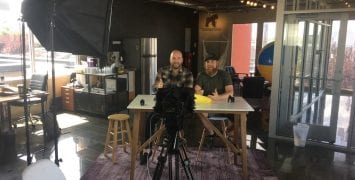When working with clients, it can be hard to keep focus during a long project — or just when things aren’t going your way. Here are some top strategies to finding the motivation you had at the beginning of the project once again.
Creativity is something that has a mind of its own, which is why being a designer can absolutely suck sometimes. Being forced to work can be a huge creativity killer, and we can forget why we got into the profession in the first place. Let’s look over just a few of the methods for regaining motivation and inspiration.
1. Remind Yourself that It’s Not Work
Remember, it is not really work.
Ok, well technically, it is. It puts the bread on the table. It is important to remember, though, why we got into design in the first place — to be able to play, and let our creative minds flow, while at the same time making a living. Remember why you got into the design world in the beginning, and that you’re living the dream now. Even though it can be frustrating at times, you’re doing what you love to do.
Also, think back to the time when you got the project. Think of all the fresh ideas you had, and the dream of the outcome. Analyze your work from that initial inspiration. It’s a much duller outcome than what you had imagined? That just may be the source of interest loss.
2. Shut Out Other Responsibilities
If a project has gotten boring, you just can’t find the motivation to even start, get away from all the other business stuff. Shut off the cell phone, get out of the office, and depending on what stage of the design process you may be on, turn off the computer. Give yourself zero distraction, except for the work playtime ahead.
By doing this we can cut out extra responsibilities for the time being, and cut out extra stress. Stress can often lead our minds to think “there’s no end to all this work,” which leads us to the thought, “what’s the point?” Clear out all the extra clutter, and tell yourself, “I finally have the time to show off my creativity and what I can do.”
3. Set Goals
Admittedly, there are times during the design process that are tedious and even downright annoying. These tedious tasks, though, must be done. Whether the technical coding is what gets you, or the client’s constant need for change to your long hours of work, motivation, and inspiration can be saved by setting mini-goals along the way.
At the beginning of a project, set main goals that will help guide you along the way. Be sure to stock in plenty of the tedious-task-time a day to avoid procrastination. Along with those main goals, set up goals as change happens between the client and yourself, and for the need of the overall project.
By setting goals and completing them, you can feel on-track and accomplished as you meet them. Avoid difficult goals though, because failing time constraints can aid in losing motivation.
4. Work the Same Hours Every Day
A crazy schedule can actually lead to physiological stress and even depression. So even at a psychological level, having a steady routine can aid in keeping the stress down and the creativity flowing. When the time comes to work, you will be in the mood to work, and it will seem routine to head on over to the desk with a cup of coffee (or other caffeine beverage of your choice), and start work immediately.
Without a set schedule, one may wake up and use the, “I’ll do it later today” excuse until the day is completely lost or there isn’t enough time to get the needed work done.
Also, work the same amount of hours. If it’s for only four hours, or a full-time eight hour day, make sure it’s consistent. An inconsistent hourly day can too easily give you the excuse, “I’ll make this day a short one.” … every day.
5. Use the Right Tools
Life would be easier for all of us if we had our own personal assistants, right? Well basically, tools for web designers (and freelancers) can be great personal assistants saving us time, and usually money.
The trick is to find the right tools that are best fitted with your own organizational style. Try out different client management, invoicing, and document tools to find which is the best for you. It really helps to take the time to review some services and tools.
6. Reorganize
As things get cluttered and lost, it can make our workflow slower and much less appealing. To fix this, take the time to reorganize the design materials, emails, drafts, and more.
By doing this, you can clean up which will create a more positive workspace, remind you of all the material at hand, and perhaps even find older materials that inspired and motivated you in the first place.
7. Take a True Break
When we’ve lost motivation because we have to much to do, or for other reasons, sometimes we just need a break. Even if you’re behind and constantly feel the need to pull that all-nighter, shut down the computer for one night.
Realistically, working on something stress-free for a few hours can be 10x more effective than trying to bash away at something all day off and on. When we’re stressed we may make up excuses to keep stepping away from our workspace, not to mention provide under quality work for the tiny bit we do get done.
To take a true break from a project, turn off the computer all together sometime early in the night. Do other tasks that need to be caught up on — laundry, the dishes, a night out on the town — whatever really. Just make sure it’s time for yourself. This may even be a great opportunity to catch up on some sleep.
The next morning you can arise for work feeling refreshed and more productive than ever.
Wrapping Up
There are really a lot of things one can do to regain motivation, and some things may be discovered personally. Please share some tips you have for finding motivation for a design project.




